Yuhan Zhu
DAG: A Dual Causal Network for Time Series Forecasting with Exogenous Variables
Sep 18, 2025Abstract:Time series forecasting is crucial in various fields such as economics, traffic, and AIOps. However, in real-world applications, focusing solely on the endogenous variables (i.e., target variables), is often insufficient to ensure accurate predictions. Considering exogenous variables (i.e., covariates) provides additional predictive information, thereby improving forecasting accuracy. However, existing methods for time series forecasting with exogenous variables (TSF-X) have the following shortcomings: 1) they do not leverage future exogenous variables, 2) they fail to account for the causal relationships between endogenous and exogenous variables. As a result, their performance is suboptimal. In this study, to better leverage exogenous variables, especially future exogenous variable, we propose a general framework DAG, which utilizes dual causal network along both the temporal and channel dimensions for time series forecasting with exogenous variables. Specifically, we first introduce the Temporal Causal Module, which includes a causal discovery module to capture how historical exogenous variables affect future exogenous variables. Following this, we construct a causal injection module that incorporates the discovered causal relationships into the process of forecasting future endogenous variables based on historical endogenous variables. Next, we propose the Channel Causal Module, which follows a similar design principle. It features a causal discovery module models how historical exogenous variables influence historical endogenous variables, and a causal injection module incorporates the discovered relationships to enhance the prediction of future endogenous variables based on future exogenous variables.
Agent-as-a-Service based on Agent Network
May 13, 2025Abstract:The rise of large model-based AI agents has spurred interest in Multi-Agent Systems (MAS) for their capabilities in decision-making, collaboration, and adaptability. While the Model Context Protocol (MCP) addresses tool invocation and data exchange challenges via a unified protocol, it lacks support for organizing agent-level collaboration. To bridge this gap, we propose Agent-as-a-Service based on Agent Network (AaaS-AN), a service-oriented paradigm grounded in the Role-Goal-Process-Service (RGPS) standard. AaaS-AN unifies the entire agent lifecycle, including construction, integration, interoperability, and networked collaboration, through two core components: (1) a dynamic Agent Network, which models agents and agent groups as vertexes that self-organize within the network based on task and role dependencies; (2) service-oriented agents, incorporating service discovery, registration, and interoperability protocols. These are orchestrated by a Service Scheduler, which leverages an Execution Graph to enable distributed coordination, context tracking, and runtime task management. We validate AaaS-AN on mathematical reasoning and application-level code generation tasks, which outperforms state-of-the-art baselines. Notably, we constructed a MAS based on AaaS-AN containing agent groups, Robotic Process Automation (RPA) workflows, and MCP servers over 100 agent services. We also release a dataset containing 10,000 long-horizon multi-agent workflows to facilitate future research on long-chain collaboration in MAS.
Learning-based Estimation of Forward Kinematics for an Orthotic Parallel Robotic Mechanism
Mar 14, 2025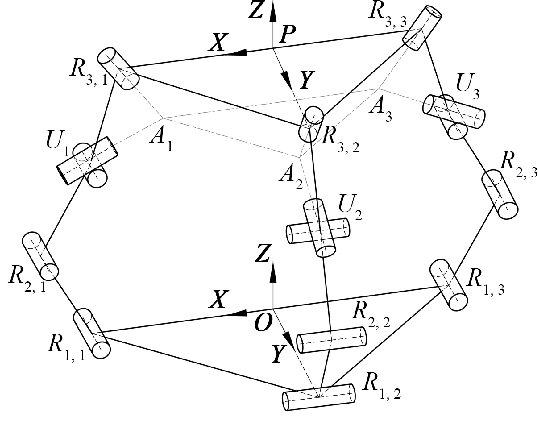
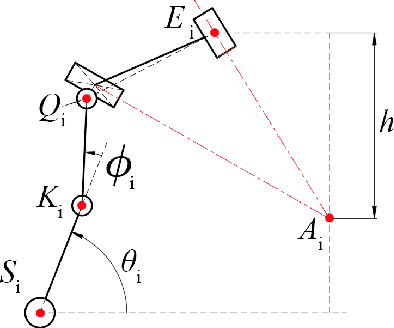

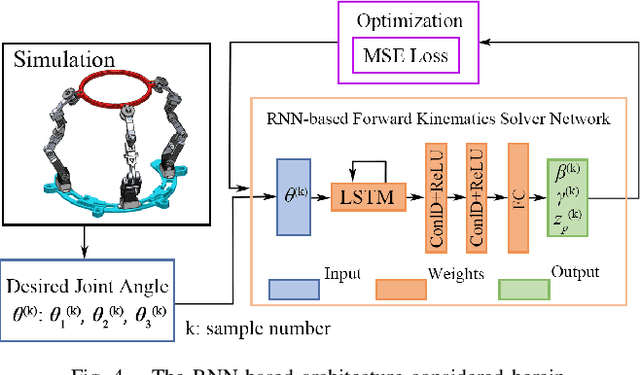
Abstract:This paper introduces a 3D parallel robot with three identical five-degree-of-freedom chains connected to a circular brace end-effector, aimed to serve as an assistive device for patients with cervical spondylosis. The inverse kinematics of the system is solved analytically, whereas learning-based methods are deployed to solve the forward kinematics. The methods considered herein include a Koopman operator-based approach as well as a neural network-based approach. The task is to predict the position and orientation of end-effector trajectories. The dataset used to train these methods is based on the analytical solutions derived via inverse kinematics. The methods are tested both in simulation and via physical hardware experiments with the developed robot. Results validate the suitability of deploying learning-based methods for studying parallel mechanism forward kinematics that are generally hard to resolve analytically.
MedMimic: Physician-Inspired Multimodal Fusion for Early Diagnosis of Fever of Unknown Origin
Feb 07, 2025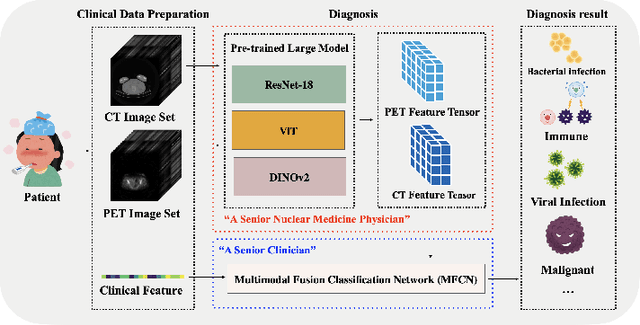
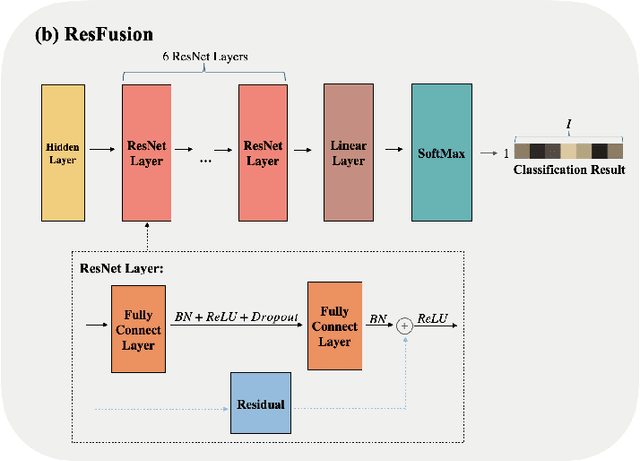
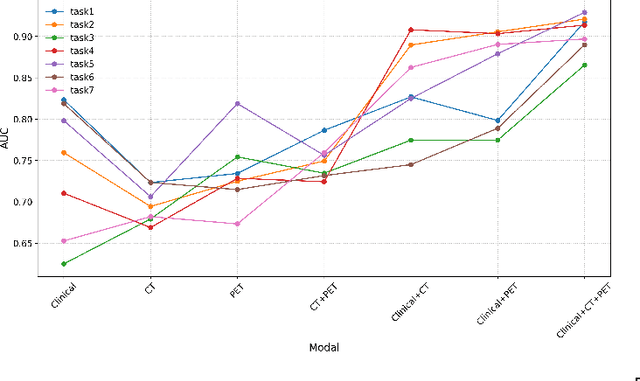
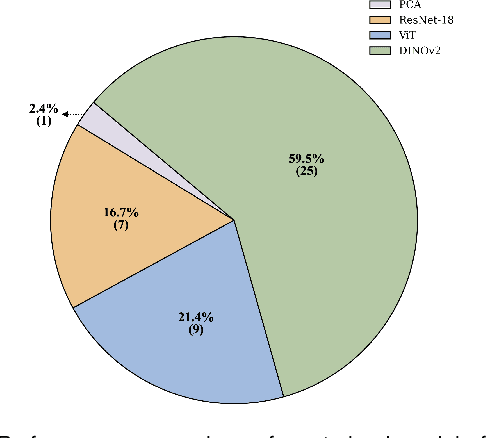
Abstract:Fever of unknown origin FUO remains a diagnostic challenge. MedMimic is introduced as a multimodal framework inspired by real-world diagnostic processes. It uses pretrained models such as DINOv2, Vision Transformer, and ResNet-18 to convert high-dimensional 18F-FDG PET/CT imaging into low-dimensional, semantically meaningful features. A learnable self-attention-based fusion network then integrates these imaging features with clinical data for classification. Using 416 FUO patient cases from Sichuan University West China Hospital from 2017 to 2023, the multimodal fusion classification network MFCN achieved macro-AUROC scores ranging from 0.8654 to 0.9291 across seven tasks, outperforming conventional machine learning and single-modality deep learning methods. Ablation studies and five-fold cross-validation further validated its effectiveness. By combining the strengths of pretrained large models and deep learning, MedMimic offers a promising solution for disease classification.
Motion-Aware Generative Frame Interpolation
Jan 07, 2025Abstract:Generative frame interpolation, empowered by large-scale pre-trained video generation models, has demonstrated remarkable advantages in complex scenes. However, existing methods heavily rely on the generative model to independently infer the correspondences between input frames, an ability that is inadequately developed during pre-training. In this work, we propose a novel framework, termed Motion-aware Generative frame interpolation (MoG), to significantly enhance the model's motion awareness by integrating explicit motion guidance. Specifically we investigate two key questions: what can serve as an effective motion guidance, and how we can seamlessly embed this guidance into the generative model. For the first question, we reveal that the intermediate flow from flow-based interpolation models could efficiently provide task-oriented motion guidance. Regarding the second, we first obtain guidance-based representations of intermediate frames by warping input frames' representations using guidance, and then integrate them into the model at both latent and feature levels. To demonstrate the versatility of our method, we train MoG on both real-world and animation datasets. Comprehensive evaluations show that our MoG significantly outperforms the existing methods in both domains, achieving superior video quality and improved fidelity.
VideoChat-Flash: Hierarchical Compression for Long-Context Video Modeling
Dec 31, 2024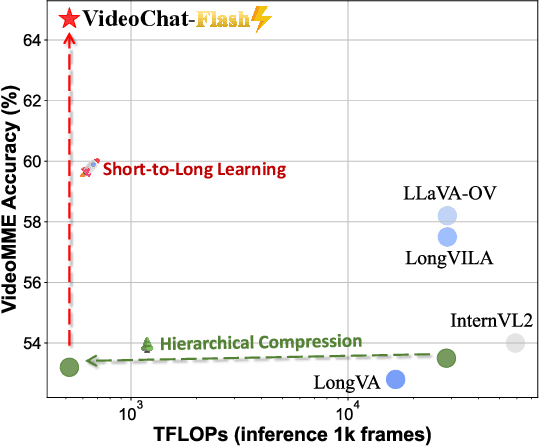
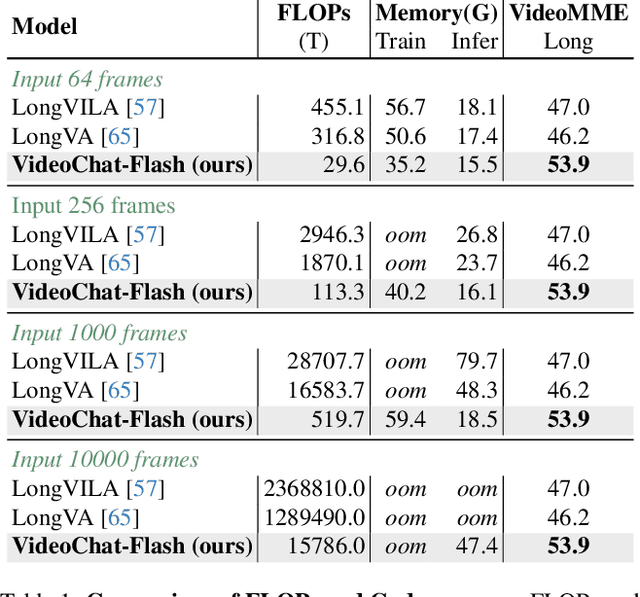

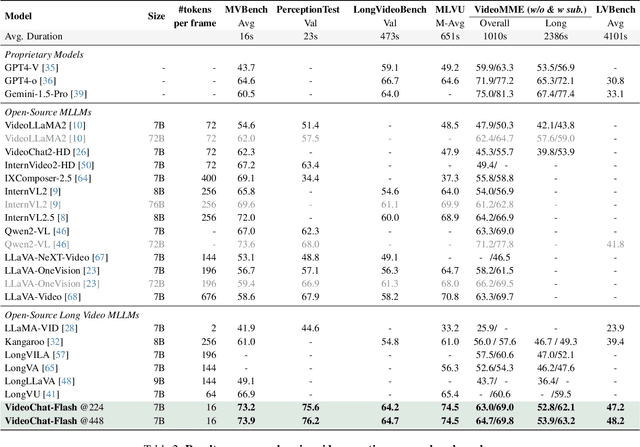
Abstract:Long-context modeling is a critical capability for multimodal large language models (MLLMs), enabling them to process long-form contents with implicit memorization. Despite its advances, handling extremely long videos remains challenging due to the difficulty in maintaining crucial features over extended sequences. This paper introduces a Hierarchical visual token Compression (HiCo) method designed for high-fidelity representation and a practical context modeling system VideoChat-Flash tailored for multimodal long-sequence processing. HiCo capitalizes on the redundancy of visual information in long videos to compress long video context from the clip-level to the video-level, reducing the compute significantly while preserving essential details. VideoChat-Flash features a multi-stage short-to-long learning scheme, a rich dataset of real-world long videos named LongVid, and an upgraded "Needle-In-A-video-Haystack" (NIAH) for evaluating context capacities. In extensive experiments, VideoChat-Flash shows the leading performance on both mainstream long and short video benchmarks at the 7B model scale. It firstly gets 99.1% accuracy over 10,000 frames in NIAH among open-source models.
Efficient Test-Time Prompt Tuning for Vision-Language Models
Aug 11, 2024



Abstract:Vision-language models have showcased impressive zero-shot classification capabilities when equipped with suitable text prompts. Previous studies have shown the effectiveness of test-time prompt tuning; however, these methods typically require per-image prompt adaptation during inference, which incurs high computational budgets and limits scalability and practical deployment. To overcome this issue, we introduce Self-TPT, a novel framework leveraging Self-supervised learning for efficient Test-time Prompt Tuning. The key aspect of Self-TPT is that it turns to efficient predefined class adaptation via self-supervised learning, thus avoiding computation-heavy per-image adaptation at inference. Self-TPT begins by co-training the self-supervised and the classification task using source data, then applies the self-supervised task exclusively for test-time new class adaptation. Specifically, we propose Contrastive Prompt Learning (CPT) as the key task for self-supervision. CPT is designed to minimize the intra-class distances while enhancing inter-class distinguishability via contrastive learning. Furthermore, empirical evidence suggests that CPT could closely mimic back-propagated gradients of the classification task, offering a plausible explanation for its effectiveness. Motivated by this finding, we further introduce a gradient matching loss to explicitly enhance the gradient similarity. We evaluated Self-TPT across three challenging zero-shot benchmarks. The results consistently demonstrate that Self-TPT not only significantly reduces inference costs but also achieves state-of-the-art performance, effectively balancing the efficiency-efficacy trade-off.
AWT: Transferring Vision-Language Models via Augmentation, Weighting, and Transportation
Jul 05, 2024Abstract:Pre-trained vision-language models (VLMs) have shown impressive results in various visual classification tasks. However, we often fail to fully unleash their potential when adapting them for new concept understanding due to limited information on new classes. To address this limitation, we introduce a novel adaptation framework, AWT (Augment, Weight, then Transport). AWT comprises three key components: augmenting inputs with diverse visual perspectives and enriched class descriptions through image transformations and language models; dynamically weighting inputs based on the prediction entropy; and employing optimal transport to mine semantic correlations in the vision-language space. AWT can be seamlessly integrated into various VLMs, enhancing their zero-shot capabilities without additional training and facilitating few-shot learning through an integrated multimodal adapter module. We verify AWT in multiple challenging scenarios, including zero-shot and few-shot image classification, zero-shot video action recognition, and out-of-distribution generalization. AWT consistently outperforms the state-of-the-art methods in each setting. In addition, our extensive studies further demonstrate AWT's effectiveness and adaptability across different VLMs, architectures, and scales.
Root Cause Localization for Microservice Systems in Cloud-edge Collaborative Environments
Jun 19, 2024Abstract:With the development of cloud-native technologies, microservice-based software systems face challenges in accurately localizing root causes when failures occur. Additionally, the cloud-edge collaborative environment introduces more difficulties, such as unstable networks and high latency across network segments. Accurately identifying the root cause of microservices in a cloud-edge collaborative environment has thus become an urgent problem. In this paper, we propose MicroCERCL, a novel approach that pinpoints root causes at the kernel and application level in the cloud-edge collaborative environment. Our key insight is that failures propagate through direct invocations and indirect resource-competition dependencies in a cloud-edge collaborative environment characterized by instability and high latency. This will become more complex in the hybrid deployment that simultaneously involves multiple microservice systems. Leveraging this insight, we extract valid contents from kernel-level logs to prioritize localizing the kernel-level root cause. Moreover, we construct a heterogeneous dynamic topology stack and train a graph neural network model to accurately localize the application-level root cause without relying on historical data. Notably, we released the first benchmark hybrid deployment microservice system in a cloud-edge collaborative environment (the largest and most complex within our knowledge). Experiments conducted on the dataset collected from the benchmark show that MicroCERCL can accurately localize the root cause of microservice systems in such environments, significantly outperforming state-of-the-art approaches with an increase of at least 24.1% in top-1 accuracy.
Dual DETRs for Multi-Label Temporal Action Detection
Mar 31, 2024Abstract:Temporal Action Detection (TAD) aims to identify the action boundaries and the corresponding category within untrimmed videos. Inspired by the success of DETR in object detection, several methods have adapted the query-based framework to the TAD task. However, these approaches primarily followed DETR to predict actions at the instance level (i.e., identify each action by its center point), leading to sub-optimal boundary localization. To address this issue, we propose a new Dual-level query-based TAD framework, namely DualDETR, to detect actions from both instance-level and boundary-level. Decoding at different levels requires semantics of different granularity, therefore we introduce a two-branch decoding structure. This structure builds distinctive decoding processes for different levels, facilitating explicit capture of temporal cues and semantics at each level. On top of the two-branch design, we present a joint query initialization strategy to align queries from both levels. Specifically, we leverage encoder proposals to match queries from each level in a one-to-one manner. Then, the matched queries are initialized using position and content prior from the matched action proposal. The aligned dual-level queries can refine the matched proposal with complementary cues during subsequent decoding. We evaluate DualDETR on three challenging multi-label TAD benchmarks. The experimental results demonstrate the superior performance of DualDETR to the existing state-of-the-art methods, achieving a substantial improvement under det-mAP and delivering impressive results under seg-mAP.
 Add to Chrome
Add to Chrome Add to Firefox
Add to Firefox Add to Edge
Add to Edge